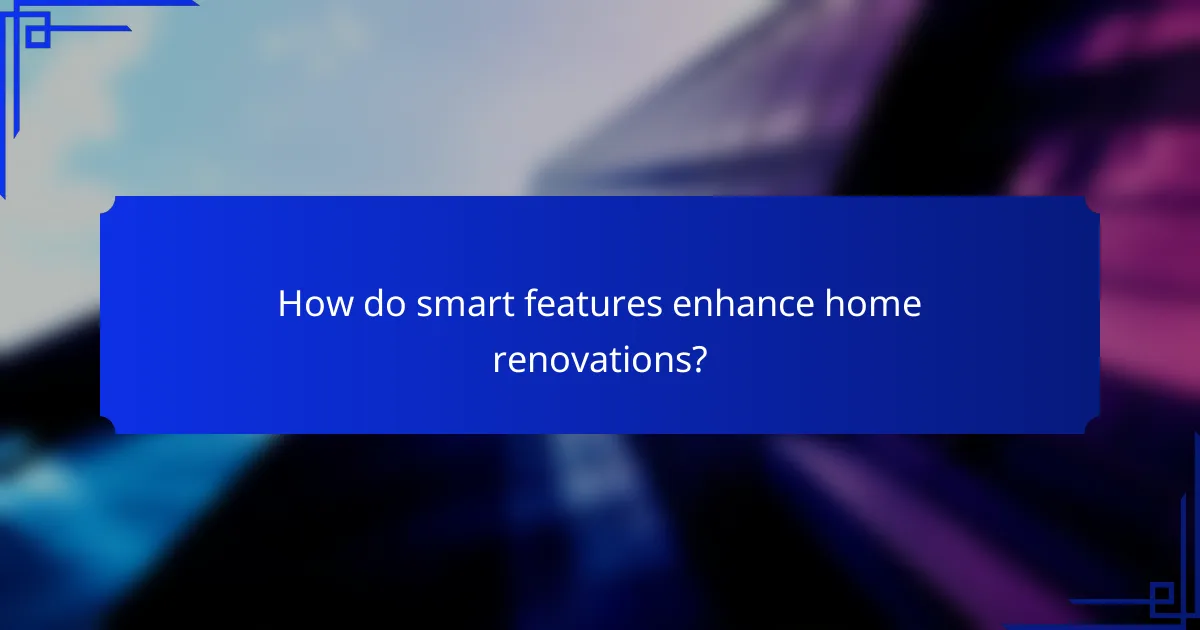Home renovation trends are increasingly centered around sustainability, smart technology, and aesthetic appeal. Homeowners are prioritizing eco-friendly materials and energy-efficient solutions, while also embracing smart features that enhance convenience and security. Additionally, current design trends emphasize minimalist styles and natural materials, creating spaces that are both functional and visually striking.

What are the latest home renovation trends in sustainability?
The latest home renovation trends in sustainability focus on reducing environmental impact while enhancing energy efficiency and aesthetic appeal. Homeowners are increasingly opting for eco-friendly materials and technologies that promote a sustainable lifestyle.
Energy-efficient appliances
Energy-efficient appliances are designed to use less energy while maintaining performance. These appliances often carry the ENERGY STAR label, indicating they meet strict energy efficiency guidelines set by the U.S. Environmental Protection Agency.
When selecting energy-efficient appliances, consider models that offer features like smart technology, which can optimize energy use based on your habits. For example, a smart refrigerator can adjust its cooling based on the contents inside, potentially saving significant energy over time.
Recycled materials
Using recycled materials in home renovations helps divert waste from landfills and reduces the demand for new resources. Common recycled materials include reclaimed wood, recycled glass, and metal products, which can add unique character to your home.
When sourcing recycled materials, look for local suppliers to minimize transportation emissions. Additionally, consider the durability and maintenance needs of these materials to ensure they are a practical choice for your renovation project.
Green roofing systems
Green roofing systems involve planting vegetation on rooftops, which can improve insulation and reduce stormwater runoff. These systems can help lower energy costs and enhance biodiversity in urban areas.
Installing a green roof requires proper structural support and a suitable waterproofing system. It’s essential to consult with professionals to assess your roof’s capacity and to select appropriate plant species that thrive in your climate.
Water-saving fixtures
Water-saving fixtures, such as low-flow faucets and dual-flush toilets, significantly reduce water consumption without sacrificing performance. These fixtures can help homeowners save on water bills while promoting conservation efforts.
When upgrading to water-saving fixtures, look for products that meet the WaterSense label standards. This ensures they are tested for efficiency and performance, providing peace of mind that you are making a sustainable choice.
Solar panel installations
Solar panel installations harness sunlight to generate electricity, offering a renewable energy source for homes. This trend is gaining traction as technology improves and costs decrease, making solar energy more accessible to homeowners.
Before installing solar panels, evaluate your roof’s orientation and shading to determine potential energy production. Additionally, consider local incentives or rebates that can offset installation costs, making solar energy a more viable option for your renovation.

How do smart features enhance home renovations?
Smart features significantly enhance home renovations by improving energy efficiency, convenience, and security. These technologies allow homeowners to automate tasks, monitor systems remotely, and optimize resource usage, leading to a more sustainable and comfortable living environment.
Smart thermostats
Smart thermostats adjust heating and cooling based on your habits, optimizing energy consumption. Many models learn your schedule and preferences, allowing for automatic temperature adjustments that can save homeowners up to 10-15% on energy bills annually.
When selecting a smart thermostat, consider compatibility with your HVAC system and features like remote access via smartphone apps. Popular options include the Nest Learning Thermostat and Ecobee SmartThermostat, both of which offer user-friendly interfaces and energy-saving capabilities.
Home automation systems
Home automation systems integrate various smart devices, allowing centralized control through a single platform. This can include managing lighting, heating, and security systems, enhancing convenience and efficiency.
When planning a home automation upgrade, consider systems like Google Home or Amazon Alexa, which support a wide range of devices. Ensure that your chosen system is compatible with existing devices and offers scalability for future additions.
Smart lighting solutions
Smart lighting solutions provide customizable lighting options that can be controlled remotely or set to schedules. These systems can enhance ambiance and security while reducing energy consumption by using LED technology.
Look for features such as dimming capabilities, color changing, and integration with home automation systems. Brands like Philips Hue and LIFX offer versatile options that can be tailored to fit various moods and activities throughout your home.
Security systems with AI
Security systems equipped with AI enhance home safety by providing real-time monitoring and intelligent alerts. These systems can differentiate between familiar faces and strangers, reducing false alarms and improving response times.
When choosing an AI-driven security system, consider options like Ring or Arlo, which offer features such as motion detection, video recording, and remote access. Ensure that the system complies with local regulations regarding surveillance and privacy to maintain compliance and peace of mind.

What aesthetic trends are popular in home renovations?
Current aesthetic trends in home renovations focus on creating spaces that are not only visually appealing but also functional and sustainable. Popular styles include minimalist designs, the use of natural materials, bold color palettes, and open floor plans, each contributing to a modern yet timeless look.
Minimalist designs
Minimalist designs emphasize simplicity and functionality, often featuring clean lines and uncluttered spaces. This approach encourages homeowners to prioritize essential elements, reducing visual noise and enhancing tranquility. Key considerations include choosing furniture with sleek profiles and limiting decorative items.
To achieve a minimalist aesthetic, opt for a neutral color palette, incorporating whites, grays, and earth tones. This creates a cohesive look that feels spacious and airy. Remember to focus on quality over quantity, investing in fewer but more impactful pieces.
Natural materials
Natural materials are increasingly favored in home renovations for their aesthetic warmth and sustainability. Wood, stone, and bamboo are popular choices that bring an organic feel to interiors. These materials not only enhance visual appeal but also contribute to healthier indoor air quality.
When selecting natural materials, consider their source and sustainability. Look for reclaimed wood or locally sourced stone to minimize environmental impact. Incorporating these elements can create a harmonious connection between indoor spaces and the natural environment.
Bold color palettes
Bold color palettes are making a comeback, adding personality and vibrancy to home interiors. Homeowners are experimenting with deep hues like navy, emerald green, and rich terracotta, often as accent walls or in furniture choices. This trend allows for creative expression while still maintaining a balanced overall design.
To effectively use bold colors, consider pairing them with neutral tones to prevent overwhelming the space. Accent pieces like cushions, artwork, or rugs can introduce these colors without committing to a full room makeover. Test paint samples in different lighting to find the perfect shade.
Open floor plans
Open floor plans continue to be a popular choice in home renovations, promoting a sense of spaciousness and flow between living areas. This layout encourages social interaction and flexibility in how spaces are used. Key considerations include the placement of furniture and the use of area rugs to define different zones.
When designing an open floor plan, ensure that the kitchen, dining, and living areas are visually cohesive. Use consistent flooring and color schemes to tie the spaces together. Additionally, consider incorporating multifunctional furniture to maximize usability without sacrificing style.

What are the costs associated with sustainable renovations?
The costs of sustainable renovations can vary significantly based on the scope of the project, materials used, and technology integrated. Homeowners should expect to invest in energy-efficient upgrades, smart technology, and sustainable materials, which can lead to long-term savings on utility bills.
Average cost of energy-efficient upgrades
Energy-efficient upgrades typically range from a few hundred to several thousand dollars, depending on the type of improvements. Common upgrades include insulation, energy-efficient windows, and HVAC systems. For example, replacing windows can cost between $300 and $1,000 per window, while insulation might range from $1 to $3 per square foot.
Investing in energy-efficient appliances can also add to initial costs but often results in significant savings over time. Look for appliances with the ENERGY STAR label, which can save you around 10-50% on energy costs compared to standard models.
Budgeting for smart technology
Smart home technology can enhance energy efficiency but requires careful budgeting. Basic smart devices, like thermostats and lighting, can cost between $100 and $300 each. More advanced systems, such as whole-home automation, can run into the thousands, depending on the complexity and integration level.
When budgeting, consider installation costs, which may require professional help. It’s wise to prioritize devices that offer the greatest energy savings, such as smart thermostats, which can reduce heating and cooling costs by up to 10-15%.
Cost comparison of materials
Choosing sustainable materials can significantly impact renovation costs. For instance, reclaimed wood might cost more upfront than traditional lumber, but it offers unique aesthetics and environmental benefits. Expect to pay about 20-30% more for reclaimed materials compared to new ones.
Additionally, eco-friendly materials like bamboo flooring or recycled glass countertops can range from moderate to high prices. While the initial investment may be higher, these materials often provide durability and lower maintenance costs, making them a worthwhile consideration for long-term value.

How to choose the right features for your renovation?
Choosing the right features for your renovation involves assessing your personal needs, budget, and the potential value added to your home. Focus on elements that enhance sustainability, incorporate smart technology, and align with your aesthetic preferences.
Assessing your lifestyle needs
Begin by evaluating how you use your space. Consider factors such as family size, daily routines, and future plans. For instance, if you frequently entertain, an open floor plan or a spacious kitchen may be essential.
Think about sustainability features that fit your lifestyle. Energy-efficient appliances, water-saving fixtures, and sustainable materials can enhance comfort while reducing environmental impact. Prioritize features that will genuinely improve your daily life.
Evaluating return on investment
When selecting renovation features, consider their potential return on investment (ROI). Features like kitchen upgrades, energy-efficient windows, and smart home technology often yield higher returns compared to more personalized choices.
Research local market trends to understand which renovations are most valued in your area. In the U.S., for example, kitchen remodels can recoup around 60-80% of their cost, while bathroom renovations often return 50-70%. Balance your personal preferences with features that appeal to future buyers.
